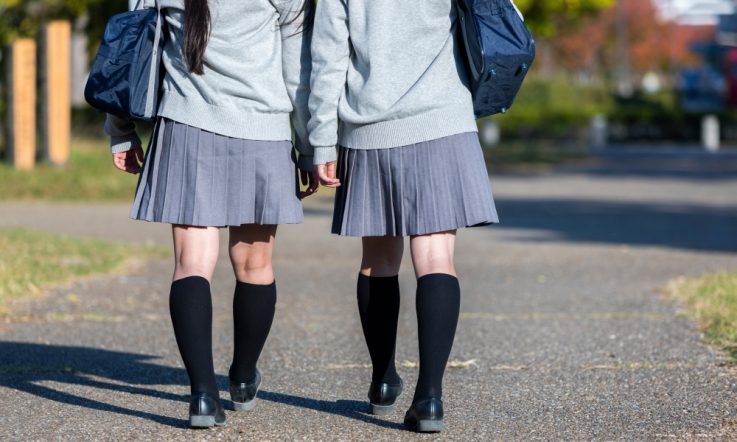School absence has an impact on student outcomes, so being aware of attendance rates for your class, year group, or whole school is important. You also need to understand why your students are missing school – it could be for a whole range of reasons. With this information to hand, what will make a difference? That’s the topic of a new Churchill Fellowship research report from Dr Kirsten Hancock.
In this Q&A, we chat to her about student attendance in Australia pre- and post-pandemic, and the findings from this international project, which saw her travel to the US and New Zealand to find out what’s having an impact in these countries and what’s not.
Hi Kirsten, thanks for catching up with us. What’s your current role and how did you get involved with this exciting project?
I’ve been at The Smith Family for 2-and-a-half years, and currently I’m National Manager, Research and Evaluation. I’m responsible for monitoring outcomes for students on our Learning for Life scholarship and developing research and publications to understand how students experiencing disadvantage can be better supported.
When I was first awarded the Churchill Fellowship in 2019, I was a Senior Research Fellow at the Telethon Kids Institute. At the time, I had just completed a PhD investigating the reasons for missing school and the types of impacts different absences might have on student outcomes. I was due to travel for the Fellowship in 2020, but with the COVID-19 pandemic, I postponed the travel until May 2023.
What was the aim of your Fellowship research, and why did you decide to focus on this topic?
I had researched the topic of student attendance since 2013 and was very good at describing trends and problems, but I had very little evidence to draw on about what makes a difference. The focus of the Churchill Fellowship was to talk to people in other contexts to understand their experiences with student attendance problems and the best ways to respond.
The travel delay caused by COVID ended up being a blessing in disguise, because student attendance is far more prominent now than in 2019, and we’re seeing consistent trends internationally. The pandemic and subsequent declines in student attendance led to a sharper focus on how we can best respond; so, we’re learning more all the time.
What do we know about student attendance in Australia?
Student attendance rates gradually declined in the 5 years before the pandemic. For example, attendance rates for year 7-10 students declined from 91.2% in 2015 to 89.9% in 2019. This difference doesn’t sound like much – it’s an extra 2.5 days across the school year – but it all adds up. If you think of a high school with 500 year 7-10 students, that’s an extra 1,250 student days missed.
Attendance rates declined even further in 2022, to 84.7% for year 7-12 students, meaning the typical number of days missed increased from about 17 days in 2015 to 29 days in 2022, which is about 6 weeks of school. That’s a lot of missed learning opportunities for Australian students.
These figures vary a lot across schools, where some schools might have attendance rates at 95% and others at 80% or lower. While the national data show that the declines I’ve mentioned have occurred across all states and territories, sectors, and year levels, we did see slightly greater declines for the students who were already struggling to attend school – for example, for students experiencing educational disadvantage.
What did your Fellowship investigation involve?
Over 4 weeks, I travelled to 2 countries, 9 cities and had 26 meetings with around 50 people. These meetings included discussions with people from different backgrounds, including education, law, psychology, sociology, history and social work. I spoke to educators, policymakers, researchers and academics, and others who have worked in this space for a long time. I then reflected on those meetings in a summary report when I came home (Hancock, 2023).
What did you find when it came to reasons for low student attendance?
Understanding the reasons for low attendance is fundamental to figuring out what to do next. Unfortunately, we don’t have very good data to identify specific reasons for missing school or how these reasons have changed in recent years. We do know that the most common reason is illness, and 2022 was particularly bad for that, as COVID-19 was still circulating in the community.
However, there are so many different factors that contribute to low attendance, and this is what makes it such a challenging issue. These factors can include family circumstances, bullying or social issues at school, feeling overwhelmed with academic challenges, engagement problems, socioeconomic and transport problems, anxiety and other mental health problems … to name some of the main ones.
These have always been contributing factors, but we’ve seen them have more significant effects in recent years. After COVID-19, students were more inclined to stay home if they were unwell with something else, and some students were experiencing heightened anxiety about returning to school. In some cases, the cost of living and rent increases meant families had to move to more affordable areas, meaning that students had to move to a new school or had longer to travel to get to school. There was also some research from England (Burtonshaw & Dorrell, 2023) suggesting that family attitudes towards the value of regular attendance have also changed post-pandemic, where students and parents question the validity of the every day counts message. Teacher workforce pressures are also relevant, as relationships between students and teachers are important for learning engagement. Teacher shortages and increased turnover make it more challenging to establish and maintain those relationships.
We can’t attribute the recent declines in attendance to one or 2 things. There are a whole range of changes that have contributed to lower attendance.
Were there any surprises in that list of reasons and factors for you?
Not at all. None of these are new issues; we’re just seeing more schools, families, and students experiencing more of these issues.
You looked at strategies that didn’t work, and some of the changes happening to improve current practices. Can you share some of those findings?
Several go-to responses make very little difference or actively undermine efforts to improve attendance outcomes.
The approaches that don’t work are all underpinned by a misunderstanding of the reasons students miss school or are based on assumptions or stereotypes that may not be true. The most common assumption I encounter is that parents are not motivated enough to ensure their children attend school, but we don’t have much evidence pointing to parent motivation as a leading cause. While it may be valid for a small minority of parents, it’s not for everyone else. So, the punitive strategies that fine parents for low attendance or the initiatives that reward perfect attendance ignore all those other factors contributing to whether or not a student attends school, and they do nothing to positively change how parents value education. And if you’re not addressing the actual causes, attendance won’t improve.
Similarly, one of my colleagues described attendance as a symptom of another problem, but not the problem itself. This is a helpful way to think about attendance, because it steers you to think about the underlying causes that need addressing, rather than focussing on attendance, which is simply the outcome of that problem.
One of the most exciting changes I heard about was in Illinois. Until recently, they had very similar attendance laws to what we have now. These laws mandate compulsory student attendance, where parents are responsible for ensuring students attend school and fined or prosecuted if they don’t. In 2022, Illinois legislators removed punitive language from the laws and adopted a social-emotional wellbeing lens to address attendance issues. Rather than punishing families for factors that might be beyond their control, the laws – and the policies that filtered through as a result – now focus on the actual causes of why students miss school and supporting families to address those causes.
The legal changes in Illinois were so interesting. I never considered the attendance laws to be that consequential, as very few parents are prosecuted or fined in Australia. But I learned that the legal framework is vital for policy development and implementation and how that flows into schools’ work. One of the powerful things about that change is that it removes that fallback option of punishing families and making assumptions about their circumstances and motivations. This change forces a consideration of the actual causes of low attendance for individual students. I would love to see this happen in Australia, as it would prompt a critical public discussion about school attendance. Ideally, this conversation would include an acknowledgement that our education system as a whole doesn’t work for all students, yet all students are expected to fit in with the requirements of the system. The aim isn’t increased compliance, rather it’s about enabling learning opportunities for all students.
Another problem is this idea of ‘waiting to fail’. We can’t always see attendance problems until the end of a semester or year, when a student has already missed a significant amount of school. We need to get much better at using data to identify concerning changes early and be proactive at addressing them straight away, as well as having a range of strategies ready to hand when problems do arise.
We also need to understand better which absences are problematic for which students. It’s not the case that all absences have the same impact. Some students might be very capable of catching up after a 2-week family holiday, whereas a 2-week break in learning for another student who has lost a family member may be devastating for their engagement at school. Combining attendance information with other data on changes in achievement or social-emotional factors can help identify which students might need more help. This sounds like more work, but the schools I met with said that doing this helped them to focus their efforts.
Finally, another significant barrier has been limited published data on tried and tested approaches. We know that schools already work very hard to address attendance, but we know very little about how effective those strategies are or the best ways of combining them to support students. We also need that information to determine what isn’t helping so that schools or other supports do not waste their time.
So, highlighting the things that aren’t working is one aspect of your report, but as you mentioned, we need to tackle the question of what we can do instead. In your report, you make the point there’s limited research on tried and tested approaches, but you do share 2 promising strategies.
Besides examining and updating our attendance laws, I’d like to see more data collection on the strategies that schools are implementing and the extent of their impact. New Zealand started doing this last year, and I’ll be very interested to see what they find. In the US, some schools use a data system that tracks attendance against the strategies they’ve been applying, allowing them to learn which strategies have more impact and to refine those strategies as they’re implemented.
More broadly, the most helpful development in recent years has been the Multi-Tiered System of Supports framework. This framework helps identify the multiple strategies needed for different levels of attendance. The schools I spoke to who used this framework said it was helpful for arranging the pieces they were already doing and identifying gaps where they needed more support.
During my travel, Attendance Works (a US-based attendance website) released their Attendance Playbook (Jordan, 2023), and this provides a really helpful resource identifying evidence-based strategies at the different levels of attendance. The Playbook points out areas we need to be cautious about, and they also released an implementation guide that can help schools with delivering and evaluating those strategies. I can’t recommend this resource enough!
You’ve also made 5 recommendations in your Fellowship report?
The recommendations include:
1. Reframing how we talk about attendance, starting with reexamining the laws and their language to focus on the underlying causes of low attendance.
2. Developing better systems for identifying and addressing causes early.
3. Combining attendance data with other data sources (like achievement) to identify when low attendance is causing problems elsewhere to prioritise the students who need greater support.
4. Helping schools to implement the multi-tiered system of supports in their local contexts.
The fifth recommendation was that the government support an Australian version of Attendance Works, which would help implement the 4 recommendations above. The US-based Attendance Works is a free resource for all schools, and it takes on multiple roles, including one-on-one consulting with schools and education districts, summarising emerging research findings, lobbying governments and education departments on attendance policies, and public campaigns promoting the value of regular attendance. Having a go-to resource that provides consistent information for schools, students, and families in all states and territories (not to mention internationally!) would be a tremendous resource. It wouldn’t cost much – the US outfit has just a handful of staff, but they have enormous reach, including Australia.
What’s next for you in terms of the research and your work? What are you hoping the impact of this report will be?
In the short term, I aim to get this information to the people who need it. These people are school leaders, education departments and ministerial offices, and those in the domains that need to support this work, such as health, community organisations, non-profits, research organisations, etc. I’m still disseminating the report, leading to briefings, meetings, and presentations to discuss further. I’m just getting started.
In the long term, my goal is to change how attendance is thought about and responded to, as this is needed to shift outcomes. Attendance is not a new problem, but it is showing up in new ways and contexts. We can’t improve by continuing to use the same old approaches.
Dr Kirsten Hancock’s Churchill Fellowship report – Student absenteeism is a symptom of a possible problem, not the problem itself – includes more information on the research around attendance data, case studies from 2 Chicago schools, and resources for educators, support staff and policymakers. To download a copy visit her Fellows page on the Churchill Trust website.
References
Burtonshaw, S., & Dorrell, E. (2023). Listening to, and learning from, parents in the attendance crisis. Public First. publicfirst.co.uk/wp-content/uploads/2023/09/ATTENDANCE-REPORT-V02.pdf (12.3MB)
Jordan, P. (2023). Attendance Playbook: Smart strategies for reducing student absenteeism post-pandemic. FutureEd & Attendance Works. www.future-ed.org/wp-content/uploads/2023/05/Attendance-Playbook.5.23.pdf
Hancock, K. (2023). Student absenteeism is a symptom of a possible problem, not the problem itself. Winston Churchill Trust.
As a teacher, or a school leader, how do monitor your attendance data? Do you understand the reasons behind absences?
In this article, Kirsten Hancock recommends schools combine their attendance data with other data to identify when absence is having a knock-on effect elsewhere. What data could you combine in your own school? How could this help you prioritise the support you give to students?



